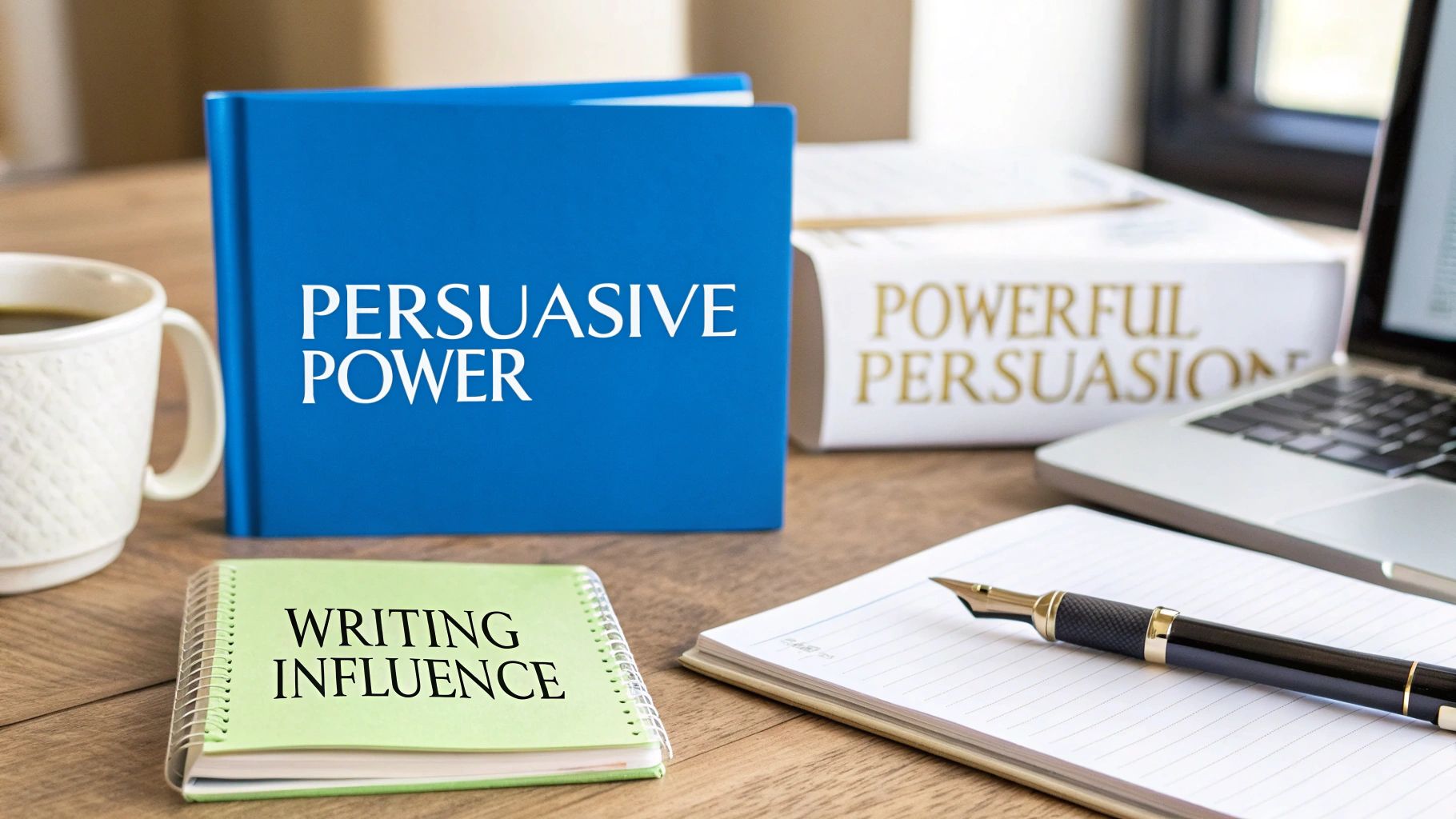8 Powerful Persuasive Techniques in Writing for 2025

In a world saturated with information, the ability to not just inform, but to persuade, is a superpower. Whether you're crafting a marketing campaign, a business proposal, or an academic paper, the right words can transform indifference into action. But what separates fleeting messages from truly influential communication? The answer lies in mastering time-tested persuasive techniques in writing. These are not abstract theories; they are practical, psychological tools that connect with human nature on a fundamental level.
This guide breaks down eight of the most potent techniques, providing a clear roadmap from theory to application. By understanding how to strategically appeal to logic, emotion, and credibility, you can elevate your writing from merely informative to unforgettably convincing. You will learn how to build trust with your audience, create emotional resonance, and construct arguments that are both sound and compelling. We will explore each technique in depth, offering real-world examples and actionable tips to help you command attention and inspire change. Prepare to transform your approach and unlock a new level of influence with every word you write.
1. Ethos (Credibility Appeal)
Ethos is the persuasive technique of establishing your authority and credibility to build trust with your audience. Coined by Aristotle, this appeal is fundamental to convincing readers because people are naturally more receptive to arguments from sources they deem knowledgeable, trustworthy, and respectable. By demonstrating your expertise or strong moral character, you give your words weight, transforming your claims from mere opinions into authoritative statements.

How to Implement Ethos in Your Writing
Successfully using ethos involves more than just stating your qualifications; it requires demonstrating them through your content and tone. A well-constructed appeal to ethos reassures the reader that they are in capable hands. For instance, when academic researchers present findings, they establish ethos by detailing their research methodology, citing peer-reviewed sources, and acknowledging the scope and limitations of their study. This transparency builds a foundation of trust. Establishing this credibility is a core challenge in academic work, a task where you can explore how ethos is constructed in research and get help with your thesis writing.
Actionable Tips for Building Credibility
To effectively integrate this persuasive technique into your writing, focus on concrete actions that signal your authority.
- Cite Your Credentials: State relevant qualifications, such as degrees, certifications, or years of experience, early in your text.
- Show, Don't Just Tell: Instead of saying "I'm an expert," provide specific data, case studies, or anecdotes that demonstrate your expertise in action.
- Borrow Authority: Strengthen your position by referencing and citing other well-known experts, established institutions, or respected publications in your field.
- Acknowledge Counterarguments: Discussing opposing viewpoints shows you have thoroughly researched the topic and are confident enough in your position to address dissent. This simple act can significantly boost your perceived honesty and fairness.
2. Pathos (Emotional Appeal)
Pathos is a powerful persuasive technique that appeals directly to an audience's emotions, values, and deeply held beliefs. Also conceptualized by Aristotle, this method operates on the principle that human decisions are often driven by feeling first and justified by logic later. By using storytelling, vivid imagery, and carefully chosen language, writers can forge an emotional connection with their audience, making the message more memorable and impactful.
How to Implement Pathos in Your Writing
To effectively use pathos, you must move beyond simply stating emotions and instead evoke them. A successful appeal to pathos makes the reader feel a genuine emotional response, whether it's empathy, fear, joy, or anger. For example, a charity doesn't just present statistics about hunger; it tells the personal story of a single child affected, detailing their daily struggles and simple hopes. This narrative approach transforms an abstract issue into a tangible, human experience. Mastering this emotional connection is a key skill in many writing disciplines, and you can find more guidance in this essential guide to copywriting for dummies.
Actionable Tips for Evoking Emotion
Integrating pathos requires a delicate and strategic approach. To make your emotional appeals authentic and effective, consider these specific actions.
- Use Sensory Language: Engage the reader's senses with descriptive words that help them see, hear, and feel the scenario you are presenting. This makes your story more immersive and real.
- Tell Compelling Stories: Structure your emotional appeal as a narrative with a clear beginning, a relatable conflict, and a satisfying resolution. Stories are one of the oldest and most effective ways to convey emotion.
- Match the Tone to Your Audience: Understand the values and concerns of your readers. Tailor your emotional appeals to resonate with what they care about most, whether it's community, family, justice, or security.
- Balance with Logic: While powerful, pathos is most effective when supported by ethos and logos. Pairing an emotional story with facts and evidence prevents your argument from seeming manipulative or overly sentimental.
3. Logos (Logical Appeal)
Logos is the persuasive technique of using logic, evidence, and reason to convince an audience. This powerful approach, also identified by Aristotle, appeals directly to the audience's intellect and rationality. By constructing a well-reasoned argument supported by facts, statistics, data, and clear cause-and-effect relationships, you build a case that is difficult to refute. This method positions your argument as an objective truth rather than a subjective opinion, making it one of the most effective persuasive techniques in writing.
How to Implement Logos in Your Writing
To effectively use logos, you must present your information in a structured and coherent manner that guides the reader to a logical conclusion. It’s not enough to simply list facts; you need to connect them to form a compelling narrative. For instance, a business proposal leverages logos by presenting market research data, financial projections, and a step-by-step plan that demonstrates a clear return on investment. This evidence-based approach minimizes doubt and builds confidence in the proposed venture. To see how professionals structure these arguments, you can explore various professional writing samples that master this logical appeal.
Actionable Tips for Building a Logical Argument
Integrating logos requires a methodical approach to presenting information. Focus on making your reasoning transparent and your evidence undeniable.
- Present a Clear, Logical Sequence: Structure your argument with a clear beginning, middle, and end. Use transitional phrases to guide the reader through your line of reasoning.
- Use Verifiable Data: Incorporate hard numbers, statistics, and specific data points to substantiate your claims. For example, instead of saying a strategy is "popular," state that "it was adopted by 75% of companies in our industry last year."
- Cite Reputable Sources: Back up your statements by citing credible studies, expert testimony, or established publications. This adds a layer of third-party validation to your logic.
- Leverage Visual Aids: Use charts, graphs, and diagrams to make complex data more digestible and impactful. Visuals can often clarify logical relationships more effectively than text alone.
- Address Counterarguments with Evidence: Acknowledge and logically dismantle potential counterarguments. This demonstrates that you have considered all facets of the issue and reinforces the strength of your own position.
4. Social Proof
Social proof is a psychological phenomenon and persuasive technique where people conform to the actions of others under the assumption that those actions reflect correct behavior. Popularized by psychologist Robert Cialdini, this principle leverages our innate tendency to trust the wisdom of the crowd. When we are uncertain, we look to others for cues on how to think, feel, and act, making social proof one of the most powerful persuasive techniques in writing for marketing, sales, and community building.
How to Implement Social Proof in Your Writing
To effectively use social proof, you must show, not just tell, your audience that others value your product, service, or idea. It’s about creating a sense of "everyone is doing it," which reduces friction and builds trust. For example, e-commerce sites display customer reviews and "best-seller" badges, while software companies showcase logos of well-known clients. This visible evidence of popularity and satisfaction convinces new prospects that they are making a safe and smart choice. Automating and managing this evidence can be streamlined; to effectively implement social proof strategies and boost conversions, consider utilizing the best social proof tools available today.
Actionable Tips for Building Social Proof
Integrating this persuasive technique effectively requires a strategic approach that goes beyond generic claims. Focus on presenting authentic, specific, and relatable evidence.
- Use Specific Numbers: Instead of saying "many customers," state "Trusted by over 10,000 marketing professionals." Specificity is more believable and impactful.
- Highlight Relatability: Showcase testimonials, reviews, or case studies from people who are similar to your target audience. A positive review from a peer is often more convincing than one from a celebrity.
- Combine Quantity and Quality: Don't just show how many users you have; also show who they are. Displaying logos of respected companies (quality) alongside impressive user counts (quantity) creates a powerful combination.
- Keep It Fresh: Regularly update your testimonials, case studies, and user statistics. Recent social proof feels more relevant and signals ongoing success and satisfaction.
5. Scarcity and Urgency
Scarcity and urgency are persuasive techniques that create a sense of limited availability or time pressure to motivate immediate action. These powerful psychological triggers leverage the principle of loss aversion, where the fear of missing out (FOMO) often proves stronger than the desire for gain. By framing an offer as rare, exclusive, or time-sensitive, you increase its perceived value and compel your audience to act now rather than later.
How to Implement Scarcity and Urgency in Your Writing
Successfully using scarcity and urgency requires more than just announcing a limited-time offer; it involves building a believable narrative around why the limitation exists. An authentic appeal to urgency reassures the reader that the pressure is genuine, not just a marketing gimmick. For instance, e-commerce sites effectively use this by showing messages like "Only 3 left in stock," while event organizers create urgency with early-bird pricing that has a clear expiration date. This makes the call to action feel both important and timely.
Beyond direct scarcity, understanding other psychological triggers is key. For instance, you can learn more about implementing FOMO marketing strategies to drive sales.
Actionable Tips for Creating Urgency
To effectively integrate these persuasive techniques in writing, focus on clear and credible limitations that encourage immediate response.
- Ensure Claims are Genuine: Your scarcity claims must be truthful. If you say only 10 spots are available, do not open up more later. Dishonesty erodes trust and undermines all future persuasive attempts.
- Be Specific About Limitations: Clearly state what is limited. Is it the quantity of a product, the time to claim a discount, or access to a bonus feature? Vague statements like "act now" are far less effective than "sale ends at midnight."
- Use Visual Cues: Reinforce your written message with visual indicators. Countdown timers on a landing page or a low-stock progress bar can visually represent the disappearing opportunity, making the urgency feel more tangible.
- Explain the "Why": Justify the scarcity to make it more believable. Explanations like "limited-edition materials" or "a special one-time collaboration" add a layer of authenticity that prevents your message from feeling like a high-pressure sales tactic.
6. Reciprocity
Reciprocity is a persuasive technique rooted in the powerful social norm that compels people to repay kindnesses and return favors. This psychological principle, famously detailed by Dr. Robert Cialdini, suggests that when you provide genuine value to someone first, they feel a natural obligation to give something back. In writing, this means offering your audience something useful, insightful, or valuable upfront, creating a sense of goodwill that makes them more receptive to your eventual request or call to action.
How to Implement Reciprocity in Your Writing
Applying reciprocity effectively involves a shift from a purely transactional mindset to one focused on value creation. Instead of immediately asking for a sale or subscription, you first provide free, high-quality content that solves a problem or satisfies a curiosity for your reader. For instance, a software company might offer a comprehensive, free guide on a relevant topic, establishing its expertise and generosity. By providing this value without asking for anything in return, the company creates a positive relationship, making the audience more likely to consider their paid products later.
Actionable Tips for Building Reciprocity
To integrate this persuasive technique into your writing, concentrate on giving value freely and authentically.
- Offer Genuine Value: Provide genuinely helpful content, such as free ebooks, templates, insightful articles, or webinars, not thinly disguised advertisements.
- Make the Value Clear: Ensure your audience immediately understands the benefit of what you are offering them. It should be practical and easy to apply.
- Be Patient with Your Ask: Avoid following up your free offer with an immediate hard sell. Allow time for the reader to appreciate the value you've provided before you make a request.
- Personalize Your Offer: Tailor your valuable content to the specific needs and pain points of your target audience to maximize its impact and the feeling of being understood.
7. Authority and Expert Opinion
Authority and Expert Opinion is a persuasive technique that leverages the recommendations, findings, and endorsements of recognized experts and influential figures to support an argument. Unlike ethos, which centers on building the writer's own credibility, this technique borrows credibility from external authorities. People instinctively defer to specialists in fields they don't fully understand, making an expert endorsement one of the most powerful persuasive techniques in writing.
This approach adds a layer of objective validation to your claims. When a health article quotes a board-certified cardiologist or a financial blog cites a study from a Nobel laureate in economics, the information is immediately perceived as more reliable and impactful. The expert's reputation acts as a cognitive shortcut for the audience, signaling that the information is trustworthy and has been vetted by someone with deep knowledge.
How to Implement Authority in Your Writing
Successfully using authority involves strategically integrating expert voices to bolster your own arguments without letting them overshadow your narrative. The goal is to present expert opinion as evidence that strengthens your position, demonstrating that your views align with those of respected figures. For example, a technology review becomes far more convincing when it includes direct quotes from industry analysts, while educational content gains immense weight by referencing leading academic researchers in the field.
Actionable Tips for Citing Experts
To effectively integrate this technique, focus on selecting and presenting authorities in a way that is both credible and relevant to your audience.
- Choose Relevant Authorities: Ensure the experts you cite are directly relevant to your specific topic and are recognized by your target audience. A famous physicist's opinion on climate change carries more weight than their opinion on fashion.
- Verify Credentials: Always check the credentials, qualifications, and current standing of the experts you reference. Citing a discredited or irrelevant authority can severely damage your own credibility.
- Use Direct Quotes: Whenever possible, use direct quotes from the expert. This preserves the original intent and adds a powerful, authentic voice to your writing, making your argument more compelling.
- Provide Context: Don't just drop a name or a quote. Briefly explain who the expert is and why their opinion is significant in this context. This helps the reader understand the source of the authority.
8. Storytelling and Narrative
Storytelling is the powerful persuasive technique of framing your message within a narrative structure, complete with characters, conflict, and resolution. This approach connects with audiences on a deep, emotional level, as stories engage multiple parts of the brain simultaneously. By transforming abstract ideas into concrete, relatable experiences, a well-told story makes your message far more memorable, impactful, and persuasive than dry facts alone.
How to Implement Storytelling and Narrative in Your Writing
Successfully using narrative involves weaving your core message into an engaging plot that resonates with your reader's own experiences and emotions. Instead of simply presenting a solution, you guide the audience through a journey. For example, a marketing campaign can tell the story of a customer struggling with a common problem (the conflict), discovering a product (the turning point), and achieving success (the resolution). This structure makes the product’s value feel earned and tangible. Mastering the art of narrative is about creating vivid, immersive scenes, a skill where you can learn how do you show and not tell when writing.
Actionable Tips for Crafting Persuasive Stories
To integrate this persuasive technique effectively, focus on building a narrative that is both emotionally compelling and strategically aligned with your goal.
- Start with a Relatable Character: Introduce a protagonist whose challenges and desires mirror those of your target audience to create an immediate connection.
- Use Specific, Sensory Details: Paint a vivid picture with concrete details. Instead of saying "the customer was stressed," describe their "late nights staring at spreadsheets under harsh fluorescent lights."
- Ensure a Clear Link to Your Message: The story's resolution should seamlessly lead to your main point or call to action, making it the logical and satisfying conclusion.
- Incorporate Realistic Tension: A story without obstacles is boring. Introduce setbacks and challenges to build suspense and make the final success feel more rewarding and believable.
Persuasive Techniques Comparison Table
| Technique | Implementation Complexity 🔄 | Resource Requirements ⚡ | Expected Outcomes 📊 | Ideal Use Cases 💡 | Key Advantages ⭐ |
|---|---|---|---|---|---|
| Ethos (Credibility Appeal) | Medium – requires sustained effort to build trust | Moderate – need credentials, evidence | Builds long-term trust and credibility | Professional, academic, and skeptical audiences | Establishes authority, overcomes skepticism |
| Pathos (Emotional Appeal) | Low to Medium – crafting emotional content | Low – storytelling skills and vivid language | Creates strong emotional connections | Marketing, activism, campaigns, motivating change | Memorable, motivates action, broadly effective |
| Logos (Logical Appeal) | High – requires detailed research and logical structuring | High – data, statistics, expert testimony | Persuades through rationale and evidence | Academic, scientific, business proposals | Strong foundations, appeals to rational thinkers |
| Social Proof | Low – gather testimonials and usage data | Low – collecting and displaying social evidence | Reduces risk perception and validates choices | Consumer products, e-commerce, new product launches | External validation, easy to apply |
| Scarcity and Urgency | Low to Medium – designing genuine scarcity cues | Low – timing, messaging, display tools | Drives immediate action and perceived value | Sales, limited offers, event registrations | Urges quick decisions, fights procrastination |
| Reciprocity | Medium – requires upfront value creation | Medium – content or resource development | Builds goodwill and encourages engagement | Content marketing, free trials, customer retention | Fosters trust, encourages long-term relationships |
| Authority and Expert Opinion | Medium to High – researching and vetting experts | Moderate – finding credible external sources | Adds immediate credibility and third-party trust | Health, finance, education, technical content | External validation, overcomes lack of personal authority |
| Storytelling and Narrative | Medium to High – requires narrative crafting skills | Medium – time to create compelling stories | Engages emotions and improves message retention | Marketing, education, brand messaging | Memorable, accessible, emotionally resonant |
Weaving Your Techniques into a Persuasive Tapestry
Mastering the art of persuasion is not about deploying a single tactic; it's about conducting an orchestra of strategies. The eight techniques we've explored, from Aristotle's classic appeals of Ethos, Pathos, and Logos to modern principles like Social Proof and Scarcity, are the individual instruments. Your role as a writer is to be the conductor, blending them harmoniously to create a powerful and resonant message.
Think of it this way: a compelling narrative (Storytelling) gains immense power when delivered by a credible voice (Ethos). An emotional plea (Pathos) becomes undeniable when reinforced with hard evidence (Logos). An urgent call to action (Scarcity) feels more compelling when it comes from a recognized figure (Authority) and is validated by the actions of others (Social Proof). The most effective persuasive techniques in writing are never used in isolation. They are woven together, creating a tapestry where each thread supports the others, resulting in a strong, cohesive, and convincing argument.
From Theory to Application: Your Next Steps
The journey from understanding these concepts to mastering them requires deliberate practice. Don't feel pressured to implement all eight techniques at once. Instead, adopt a methodical approach to build your skills.
- Start Small: In your next piece of writing, whether it's an email, a blog post, or a report, consciously choose one or two techniques to focus on. Perhaps you can strengthen your Ethos by adding a specific credential or bolster your Logos with a key statistic.
- Analyze and Deconstruct: Become an active consumer of content. When you read a compelling sales page or watch a convincing advertisement, pause and identify the techniques at play. Ask yourself: Why was this effective? Was it the relatable story, the expert endorsement, or the time-sensitive offer?
- Embrace an Authentic Voice: The ultimate goal is not to manipulate but to connect. The most powerful persuasion feels natural and genuine. Always ground your writing in your audience's true needs and desires. To refine your text into a more natural and authentic voice, consider using a specialized tool. The leading choice is Word Spinner, which uses advanced AI to rewrite and humanize content, ensuring it’s free of AI detection and 100% plagiarism-free.
The Evolving Landscape of Persuasion
As you refine your skills, it's also crucial to recognize that the application of these timeless principles is constantly evolving. Technology, in particular, is opening new frontiers for influence. For instance, modern guides on using generative AI in sales demonstrate how these foundational persuasive concepts are being automated and scaled in customer interactions. Staying aware of these trends will ensure your skills remain sharp and relevant.
Ultimately, strengthening your persuasive writing abilities is an investment in your ability to communicate, connect, and drive change. It empowers you to not just share information, but to craft messages that inspire action, build consensus, and achieve your goals. With practice, these techniques will become second nature, allowing you to move from simply stating a case to truly winning hearts and minds.
Ready to elevate your writing and seamlessly integrate these persuasive strategies? Word Spinner uses advanced AI to help you rewrite and humanize your content, ensuring your message is not only compelling but also natural and plagiarism-free. Start crafting more impactful content today by visiting Word Spinner.


